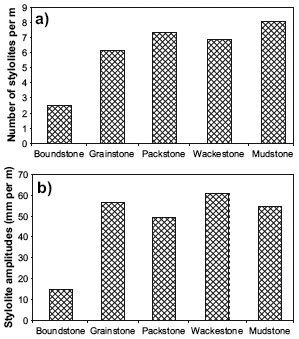| |||||||
|
|
|||||||
|
|
|||||||
| Pressure Solution and Grain Size | |||||||
|
The efficiency of pressure solution depends on the grain size of the rock and is most intense in fine-grained materials. Fine-grained materials, corresponding to large total contact area, generally favor pressure solution because they host better diffusion. Based on theoretical considerations by Rutter (1983, Equation 1), the strain rate accommodated by pressure solution is inversely proportional to the cube of the grain diameter. Peacock and Azzam (2006) reported from a core in the Khuff Formation of Upper Permian and Lower Triassic carbonates in Abu Dhabi that stylolite in boundstones is of lower density (Figure 1a) and lower amplitudes (Figure 1b) than the finer rocks in the same formation. However, other than the boundstones, there is no tendency for more pressure solution in finer rocks, as seen in grainstone, packstone, wackestone, and mudstone. | |||||||
| Reference: |
|||||||
| Peacock, D.C.P., Azzam, I. N., 2006 |
|||||||
|
Readme | About Us | Acknowledgement | How to Cite | Terms of Use | Ⓒ Rock Fracture Knowledgebase |
|||||||
